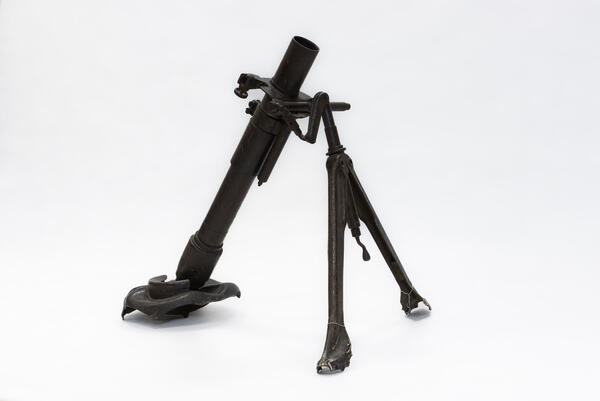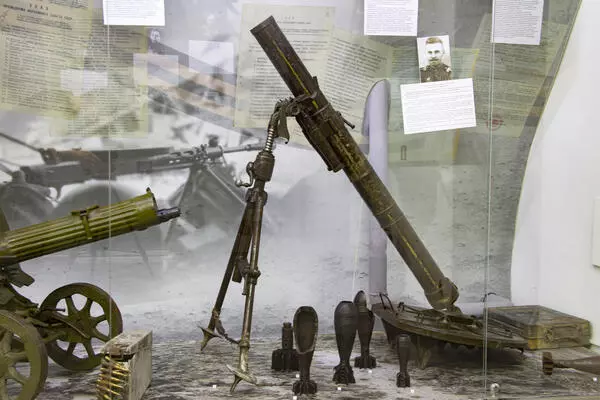The mortar was intended for fire support of rifle companies and was used during the Great Patriotic War to destroy or suppress enemy firepower and manpower both positioned in the open and on reverse slopes of an elevated terrain and sheltered positions.
The mortar was developed by the design bureau led by Boris Ivanovich Shavyrin. The mortar had a “quasitriangle design” scheme and was based on the charge ignition system of the Stokes mortar. The quasitriangle design scheme was used in most mortars in service with the Red Army during World War II. The two sides of this triangle were the barrel and the bipod, and the third side was an imaginary line passing through the ground between the support points of the barrel and the bipod.
The mortar consisted of a smooth barrel with a breech, a bipod and a base plate. The latter serving as the base of the barrel belongs to the plates of the “membrane” type. It consisted of a main sheet, to which reinforcement ribs were welded at the bottom. The recoil force resulting from a shot was transmitted through the plate to the ground. The distribution of this recoil force over a relatively large area helped to reduce pressure, so the mortar did not sink deeper into the ground when firing.
A distinctive feature of this mortar was that it fired at two fixed angles of elevation (the barrel was clamped at 45 and 75 degrees). It was also fitted with a so-called “range-regulating vent”. It was needed to discharge part of the powder gases from the bore, thereby changing the pressure of the powder gases on the shell moving along the bore. To set the desired firing range, the vent was turned using a scale graded in meters. When shooting with an elevation angle of 45 degrees with a closed range-regulating vent, the maximum firing range was 800 m. At an elevation angle of 75 degrees and with an open range-regulating vent, the minimum range was 200 m.
Only a 50mm fragmentation shell weighing 0.85 kg was developed and produced for the mortar. With a closed range-regulating vent, the initial velocity of the projectile was 95 m/s, with the vent open — 65 m/s. The mortar’s rate of fire was 30 rounds per minute.
Due to its relatively low weight (12 kg), the mortar could be carried by one person in battle, and during a campaign three mortars were stacked and transported in a special mortar carriage of the 1938 model.
The mortar was developed by the design bureau led by Boris Ivanovich Shavyrin. The mortar had a “quasitriangle design” scheme and was based on the charge ignition system of the Stokes mortar. The quasitriangle design scheme was used in most mortars in service with the Red Army during World War II. The two sides of this triangle were the barrel and the bipod, and the third side was an imaginary line passing through the ground between the support points of the barrel and the bipod.
The mortar consisted of a smooth barrel with a breech, a bipod and a base plate. The latter serving as the base of the barrel belongs to the plates of the “membrane” type. It consisted of a main sheet, to which reinforcement ribs were welded at the bottom. The recoil force resulting from a shot was transmitted through the plate to the ground. The distribution of this recoil force over a relatively large area helped to reduce pressure, so the mortar did not sink deeper into the ground when firing.
A distinctive feature of this mortar was that it fired at two fixed angles of elevation (the barrel was clamped at 45 and 75 degrees). It was also fitted with a so-called “range-regulating vent”. It was needed to discharge part of the powder gases from the bore, thereby changing the pressure of the powder gases on the shell moving along the bore. To set the desired firing range, the vent was turned using a scale graded in meters. When shooting with an elevation angle of 45 degrees with a closed range-regulating vent, the maximum firing range was 800 m. At an elevation angle of 75 degrees and with an open range-regulating vent, the minimum range was 200 m.
Only a 50mm fragmentation shell weighing 0.85 kg was developed and produced for the mortar. With a closed range-regulating vent, the initial velocity of the projectile was 95 m/s, with the vent open — 65 m/s. The mortar’s rate of fire was 30 rounds per minute.
Due to its relatively low weight (12 kg), the mortar could be carried by one person in battle, and during a campaign three mortars were stacked and transported in a special mortar carriage of the 1938 model.







